Development of a Public-Domain Measure of Two-Dimensional Rotation Ability and Preliminary Evidence for Discriminant Validity among Occupations
Abstract
1. Introduction
1.1. The Structure of Spatial Ability
1.2. Relationships with Other Individual Differences
1.3. Spatial Ability and Occupational Outcomes
1.4. The Present Study
2. Materials and Methods
2.1. Participants
2.2. Procedure
2.3. Measures
2.4. Analyses
3. Results
3.1. Relationship with Other Individual Differences
3.1.1. Cognitive Abilities
3.1.2. Personality Traits
3.2. Relationship to Job Characteristics and Occupational Choice
4. Discussion
4.1. Psychometric Properties
4.2. Relationships with Other Cognitive Abilities
4.3. Relationships with Personality Traits
4.4. Relationships Shown with Job Characteristics and Occupational Choice
4.5. Limitations and Future Directions
5. Conclusions
Supplementary Materials
Author Contributions
Funding
Institutional Review Board Statement
Informed Consent Statement
Data Availability Statement
Acknowledgments
Conflicts of Interest
References
- Ackerman, Phillip L., and Eric D. Heggestad. 1997. Intelligence, personality, and interests: Evidence for overlapping traits. Psychological Bulletin 121: 219–45. [Google Scholar] [CrossRef] [PubMed]
- Atit, Kinari, David H. Uttal, and Mike Stieff. 2020. Situating space: Using a discipline-focused lens to examine spatial thinking skills. Cognitive Research: Principles and Implications 5: 19. [Google Scholar] [CrossRef] [PubMed]
- Baenninger, Maryann, and Nora Newcombe. 1995. Environmental input to the development of sex-related differences in spatial and mathematical ability. Learning and Individual Differences 7: 363–79. [Google Scholar] [CrossRef]
- Blum, Diego, and Heinz Holling. 2018. Automatic Generation of Figural Analogies with the IMak Package. Frontiers in Psychology 9: 1286. [Google Scholar] [CrossRef] [PubMed]
- Blum, Diego, Heinz Holling, Maria S. Galibert, and Boris Forthmann. 2016. Task difficulty prediction of figural analogies. Intelligence 56: 72–81. [Google Scholar] [CrossRef]
- Brown, Windy M., Melissa Hines, Briony A. Fane, and Stephen M. Breedlove. 2002. Masculinized Finger Length Patterns in Human Males and Females with Congenital Adrenal Hyperplasia. Hormones and Behavior 42: 380–86. [Google Scholar] [CrossRef]
- Buckley, Jeffrey, Niall Seery, and Donal Canty. 2018. A Heuristic Framework of Spatial Ability: A Review and Synthesis of Spatial Factor Literature to Support its Translation into STEM Education. Educational Psychology Review 30: 947–72. [Google Scholar] [CrossRef]
- Burton, Lorelle J., and Gerard J. Fogarty. 2003. The factor structure of visual imagery and spatial abilities. Intelligence 31: 289–318. [Google Scholar] [CrossRef]
- Carroll, John B. 1993. Human Cognitive Abilities: A Survey of Factor-Analytic Studies. Cambridge: Cambridge University Press, pp. ix, 819. [Google Scholar] [CrossRef]
- Chalmers, Philip. R. 2012. mirt: A Multidimensional Item Response Theory Package for the R Environment. Journal of Statistical Software 48: 1–29. [Google Scholar] [CrossRef]
- Cohen, Cheryl A., and Mary Hegarty. 2012. Inferring cross sections of 3D objects: A new spatial thinking test. Learning and Individual Differences 22: 868–74. [Google Scholar] [CrossRef]
- Condon, David M. 2018. The SAPA Personality Inventory: An Empirically-Derived, Hierarchically-Organized Self-Report Personality Assessment Model. PsyArXiv. Available online: https://psyarxiv.com/sc4p9/ (accessed on 22 May 2023).
- Condon, David M., and William Revelle. 2014. The international cognitive ability resource: Development and initial validation of a public-domain measure. Intelligence 43: 52–64. [Google Scholar] [CrossRef]
- Condon, David M., and William Revelle. 2015. Selected personality data from the SAPA-Project: On the structure of phrased self-report items. Journal of Open Psychology Data 3: e6. [Google Scholar] [CrossRef][Green Version]
- Condon, David M., Ellen Roney, and William Revelle. 2017. A SAPA Project Update: On the Structure of phrased Self-Report Personality Items. Journal of Open Psychology Data 5: 3. [Google Scholar] [CrossRef]
- Contreras, María J., Roberto Colom, Jose’ M. Hernández, and Jose´ Santacreu. 2003. Is static spatial performance distinguishable from dynamic spatial performance? A latent-variable analysis. The Journal of General Psychology 130: 277–88. [Google Scholar] [CrossRef] [PubMed]
- Costa, Paul T., Jr., Robert R. McCrae, and David A. Dye. 1991. Facet scales for agreeableness and conscientiousness: A revision of the NEO Personality Inventory. Personality and Individual Differences 12: 887–98. [Google Scholar] [CrossRef]
- DeYoung, Colin G., Lena C. Quilty, and Jordan B. Peterson. 2007. Between facets and domains: 10 aspects of the Big Five. Journal of Personality and Social Psychology 93: 880–96. [Google Scholar] [CrossRef]
- Dror, Itiel, Stephen Kosslyn, and Wayne Waag. 1993. Visual-Spatial Abilities of Pilots. Journal of Applied Psychology 78: 763–73. [Google Scholar] [CrossRef]
- Elleman, Lorien G., Sarah K. McDougald, David M. Condon, and William Revelle. 2021. That takes the BISCUIT: Predictive accuracy and parsimony of four statistical learning techniques in personality data, with data missingness conditions. European Journal of Psychological Assessment 36: 948. [Google Scholar] [CrossRef]
- Eysenck, Michael W. 2013. Anxiety: The Cognitive Perspective. East Sussex: Psychology Press. [Google Scholar]
- Eysenck, Michael, Susanna Payne, and Nazanin Derakshan. 2005. Trait anxiety, visuospatial processing, and working memory. Cognition and Emotion 19: 1214–28. [Google Scholar] [CrossRef]
- Gohm, Carol L., Lloyd G. Humphreys, and Grace Yao. 1998. Underachievement Among Spatially Gifted Students. American Educational Research Journal 35: 515–31. [Google Scholar] [CrossRef]
- Gühne, Daniela, Philipp Doebler, David M. Condon, Fang Luo, and Luning Sun. 2021. Validity and reliability of automatically generated propositional reasoning items: A multilingual study of the challenges of verbal item generation. European Journal of Psychological Assessment 37: 325–39. [Google Scholar] [CrossRef]
- Guilford, Joy P. 1967. The Nature of Human Intelligence. New York: McGraw-Hill. [Google Scholar]
- Guilford, Joy P., and John I. Lacey, eds. 1947. Spatial tests. In Printed Classification Tests: Report No. 5. Washington, DC: US Government Printing Office, pp. 477–510. [Google Scholar]
- Hambrick, David Z., Julie C. Libarkin, Heather L. Petcovic, Kathleen M. Baker, Joe Elkins, Caitlin N. Callahan, Sheldon P. Turner, Tara A. Rench, and Nicole D. Ladue. 2012. A test of the circumvention-of-limits hypothesis in scientific problem solving: The case of geological bedrock mapping. Journal of Experimental Psychology: General 141: 397–403. [Google Scholar] [CrossRef]
- Hampson, Elizabeth, Connie L. Ellis, and Christine M. Tenk. 2008. On the Relation Between 2D:4D and Sex-Dimorphic Personality Traits. Archives of Sexual Behavior 37: 133–44. [Google Scholar] [CrossRef] [PubMed]
- Handel, Michael J. 2016. The O*NET content model: Strengths and limitations. Journal for Labour Market Research 49: 2. [Google Scholar] [CrossRef]
- Hegarty, Mary, and David A. Waller. 2005. Individual Differences in Spatial Abilities. In The Cambridge Handbook of Visuospatial Thinking. Cambridge: Cambridge University Press, pp. 121–69. [Google Scholar] [CrossRef]
- Hegarty, Mary, and David Waller. 2004. A dissociation between mental rotation and perspective-taking spatial abilities. Intelligence 32: 175–91. [Google Scholar] [CrossRef]
- Hegarty, Mary, and Maria Kozhevnikov. 1999. Types of visual–spatial representations and mathematical problem solving. Journal of Educational Psychology 91: 684–89. [Google Scholar] [CrossRef]
- Hegarty, Mary, Daniel R. Montello, Anthony E. Richardson, Toru Ishikawa, and Kristin Lovelace. 2006. Spatial abilities at different scales: Individual differences in aptitude-test performance and spatial-layout learning. Intelligence 34: 151–76. [Google Scholar] [CrossRef]
- Hegarty, Mary, Madeleine Keehner, Peter Khooshabeh, and Daniel. R. Montello. 2009. How spatial abilities enhance, and are enhanced by, dental education. Learning and Individual Differences 19: 61–70. [Google Scholar] [CrossRef]
- Humphreys, Lloyd G., and David J. Lubinski. 1996. Assessing spatial visualization: An underappreciated ability for many school and work settings. In Intellectual Talent: Psychometric and Social Issues. Baltimore: Johns Hopkins University Press, pp. 116–40. [Google Scholar]
- Johnson, Wendy, and Thomas J. Bouchard. 2005. Constructive replication of the visual–perceptual-image rotation model in Thurstone’s 1941 battery of 60 tests of mental ability. Intelligence 33: 417–30. [Google Scholar] [CrossRef]
- Kail, Robert, Philip Carter, and James Pellegrino. 1979. The locus of sex differences in spatial ability. Perception and Psychophysics 26: 182–86. [Google Scholar] [CrossRef]
- Kell, Harrison J., and David Lubinski. 2013. Spatial ability: A neglected talent in educational and occupational settings. Roeper Review: A Journal on Gifted Education 35: 219–30. [Google Scholar] [CrossRef]
- Kell, Harrison J., David Lubinski, Camilla P. Benbow, and James H. Steiger. 2013. Creativity and Technical Innovation: Spatial Ability’s Unique Role. Psychological Science 24: 1831–36. [Google Scholar] [CrossRef]
- Lakin, Joni M., and Jonathan Wai. 2020. Spatially gifted, academically inconvenienced: Spatially talented students experience less academic engagement and more behavioural issues than other talented students. British Journal of Educational Psychology 90: 1015–38. [Google Scholar] [CrossRef]
- Levine, Jonathan D., and Frederick L. Oswald. 2012. O*NET: The Occupational Information Network. In The Handbook of Work Analysis: Methods, Systems, Applications and Science of Work Measurement in Organization. London: Routledge/Taylor and Francis Group, pp. 281–301. [Google Scholar]
- Linn, Marcia C., and Anne C. Petersen. 1985. Emergence and Characterization of Sex Differences in Spatial Ability: A Meta-Analysis. Child Development 56: 1479–98. [Google Scholar] [CrossRef]
- Lohman, David F. 1979. Spatial Ability: A Review and Reanalysis of the Correlational Literature. Stanford: Stanford Univ Calif School of Education. Available online: https://apps.dtic.mil/sti/citations/ADA075972 (accessed on 22 May 2023).
- Lohman, David F. 1988. Spatial abilities as traits, processes, and knowledge. In Advances in the Psychology of Human Intelligence. Mahwah: Lawrence Erlbaum Associates, Inc., vol. 4, pp. 181–248. [Google Scholar]
- Lohman, David F. 1996. Spatial ability and g. In Human Abilities: Their Nature and Measurement. Mahwah: Lawrence Erlbaum Associates, Inc., pp. 97–116. [Google Scholar]
- Lubinski, David. 2010. Spatial ability and STEM: A sleeping giant for talent identification and development. Personality and Individual Differences 49: 344–51. [Google Scholar] [CrossRef]
- Lubinski, David. 2020. Understanding educational, occupational, and creative outcomes requires assessing intraindividual differences in abilities and interests. Proceedings of the National Academy of Sciences 117: 16720–22. [Google Scholar] [CrossRef]
- Mather, Kendall A., Sara J. Weston, and David M. Condon. Forthcoming. Scaling a common assessment of associative ability: Development and validation of a multiple-choice compound remote associates task. Under review.
- Moreau, David. 2013. Differentiating two- from three-dimensional mental rotation training effects. Quarterly Journal of Experimental Psychology 66: 1399–413. [Google Scholar] [CrossRef]
- National Center for O*NET Development. 2022. O*NET® Career Exploration Tools. O*NET Resource Center. Available online: https://www.onetcenter.org/tools.html (accessed on 3 January 2023).
- Newcombe, Nora S., and Thomas F. Shipley. 2015. Thinking About Spatial Thinking: New Typology, New Assessments. In Studying Visual and Spatial Reasoning for Design Creativity. Edited by J. S. Gero. Amsterdam: Springer, pp. 179–92. [Google Scholar] [CrossRef]
- Pazzaglia, Francesca, and Angelica Moè. 2013. Cognitive styles and mental rotation ability in map learning. Cognitive Processing 14: 391–99. [Google Scholar] [CrossRef]
- Prediger, Dale J. 1982. Dimensions underlying Holland’s hexagon: Missing link between interests and occupations? Journal of Vocational Behavior 21: 259–87. [Google Scholar] [CrossRef]
- R Core Team. 2022. R: A language and environment for statistical computing. Available online: https://www.r-project.org/ (accessed on 22 May 2023).
- Revelle, W. 2022. Psych: Procedures for Psychological, Psychometric, and Personality Research (2.2.5). Available online: https://CRAN.R-project.org/package=psych (accessed on 22 May 2023).
- Revelle, William, and Richaed E. Zinbarg. 2008. Coefficients Alpha, Beta, Omega, and the glb: Comments on Sijtsma. Psychometrika 74: 145. [Google Scholar] [CrossRef]
- Revelle, William, David M. Condon, Joshua Wilt, Jason A. French, Ashley Brown, and Lorien G. Elleman. 2017. Web- and Phone-based Data Collection using Planned Missing Designs. In The SAGE Handbook of Online Research Methods. Edited by N. G. R. Fielding, Lee and G. Blank. Sauzende Oaks: SAGE Publications Ltd., pp. 578–94. [Google Scholar] [CrossRef]
- Schneider, W. Joel, and Kevin S. McGrew. 2012. The Cattell-Horn-Carroll model of intelligence. In Contemporary Intellectual Assessment: Theories, Tests, and Issues, 3rd ed. New York: The Guilford Press, pp. 99–144. [Google Scholar]
- Shea, Daniel L., David Lubinski, and Camilla P. Benbow. 2001. Importance of assessing spatial ability in intellectually talented young adolescents: A 20-year longitudinal study. Journal of Educational Psychology 93: 604–14. [Google Scholar] [CrossRef]
- Shepard, Roger N., and Jacqueline Metzler. 1971. Mental rotation of three-dimensional objects. Science 171: 701–3. [Google Scholar] [CrossRef]
- Smith, Ian M. 1964. Spatial Ability: Its Educational and Social Significance. London: R.R. Knapp. [Google Scholar]
- Stieff, Mike. 2007. Mental rotation and diagrammatic reasoning in science. Learning and Instruction 17: 219–34. [Google Scholar] [CrossRef]
- The International Cognitive Ability Resource Team. 2014. Available online: https://icar-project.com/ (accessed on 22 May 2023).
- Uttal, David H., and Cheryl A. Cohen. 2012. Spatial thinking and STEM education: When, why, and how? In The Psychology of Learning and Motivation. Amsterdam: Elsevier Academic Press, vol. 57, pp. 147–81. [Google Scholar] [CrossRef]
- Uttal, David H., Nathaniel G. Meadow, Elizabeth Tipton, Linda L. Hand, Alden R. Alden, Christopher Warren, and Nora S. Newcombe. 2013. The malleability of spatial skills: A meta-analysis of training studies. Psychological Bulletin 139: 352–402. [Google Scholar] [CrossRef]
- van Garderen, Delinda. 2006. Spatial Visualization, Visual Imagery, and Mathematical Problem Solving of Students With Varying Abilities. Journal of Learning Disabilities 39: 496–506. [Google Scholar] [CrossRef]
- Vernon, Philip E. 1950. The Structure of Human Abilities. London: Methuen, p. 160. [Google Scholar]
- von Stumm, Sophie, and Phillip L. Ackerman. 2013. Investment and intellect: A review and meta-analysis. Psychological Bulletin 139: 841–69. [Google Scholar] [CrossRef]
- Voyer, Daniel. 2011. Time limits and gender differences on paper-and-pencil tests of mental rotation: A meta-analysis. Psychonomic Bulletin and Review 18: 267–77. [Google Scholar] [CrossRef]
- Voyer, Daniel, Carla Nolan, and Susan Voyer. 2000. The relation between experience and spatial performance in men and women. Sex Roles: A Journal of Research 43: 891–915. [Google Scholar] [CrossRef]
- Voyer, Daniel, Susan Voyer, and Philip M. Bryden. 1995. Magnitude of sex differences in spatial abilities: A meta-analysis and consideration of critical variables. Psychological Bulletin 117: 250. [Google Scholar] [CrossRef] [PubMed]
- Wai, Jonathan, David Lubinski, and Camilla P. Benbow. 2009. Spatial ability for STEM domains: Aligning over 50 years of cumulative psychological knowledge solidifies its importance. Journal of Educational Psychology 101: 817–35. [Google Scholar] [CrossRef]
- Webb, Rose M., David Lubinski, and Camilla P. Benbow. 2007. Spatial ability: A neglected dimension in talent searches for intellectually precocious youth. Journal of Educational Psychology 99: 397–420. [Google Scholar] [CrossRef]
- Weisberg, Steven M., Victor R. Schinazi, Nora S. Newcombe, Thomas F. Shipley, and Russell A. Epstein. 2014. Variations in cognitive maps: Understanding individual differences in navigation. Journal of Experimental Psychology: Learning, Memory, and Cognition 40: 669–82. [Google Scholar] [CrossRef]
- Wu, Hsin-Kai, and Priti Shah. 2004. Exploring visuospatial thinking in chemistry learning. Science Education 88: 465–92. [Google Scholar] [CrossRef]
- Xue, Yi, and Richard C. Larson. 2015. STEM crisis or STEM surplus? Yes and yes. Monthly Labor Review 2015: 11. [Google Scholar] [CrossRef]
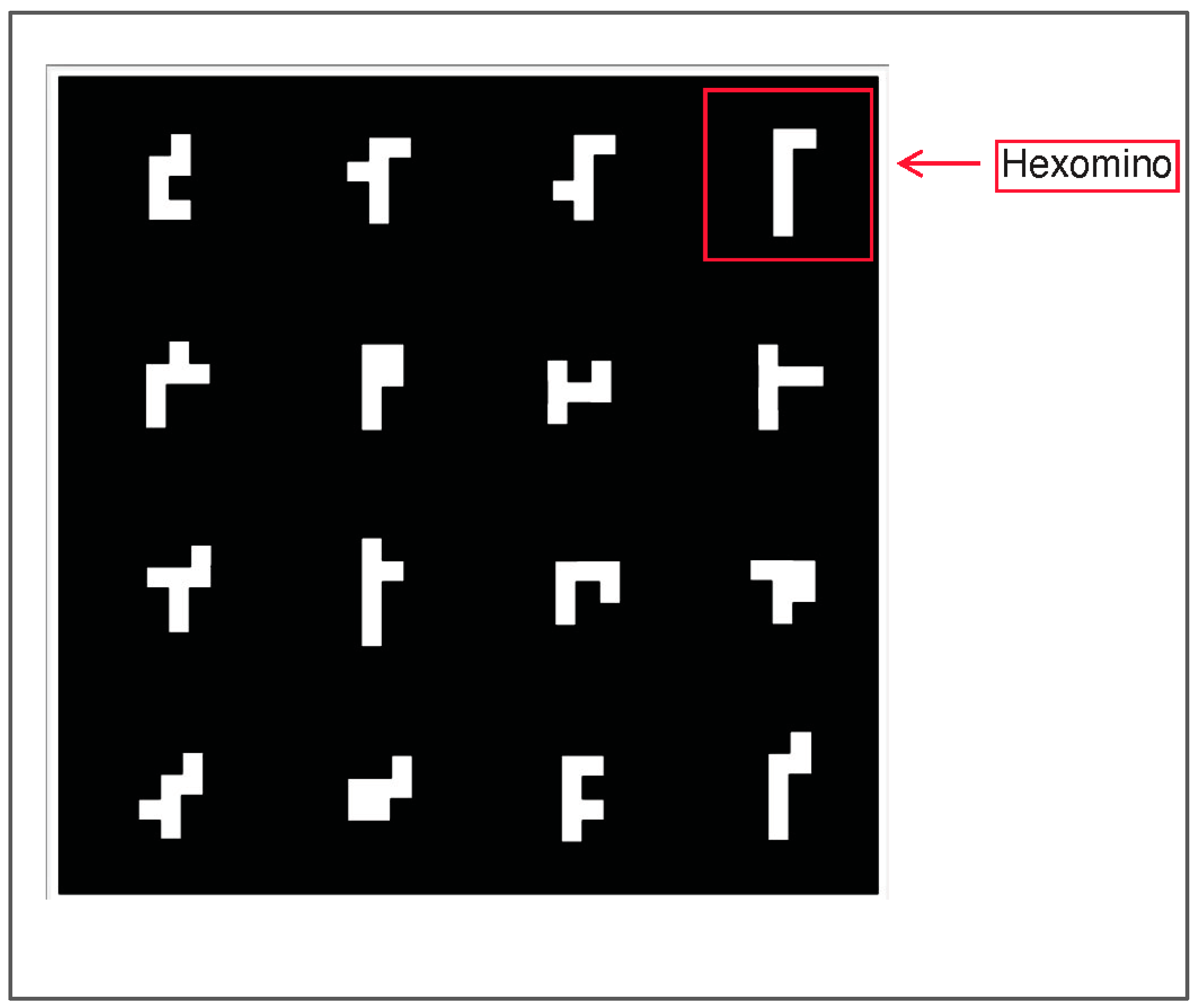
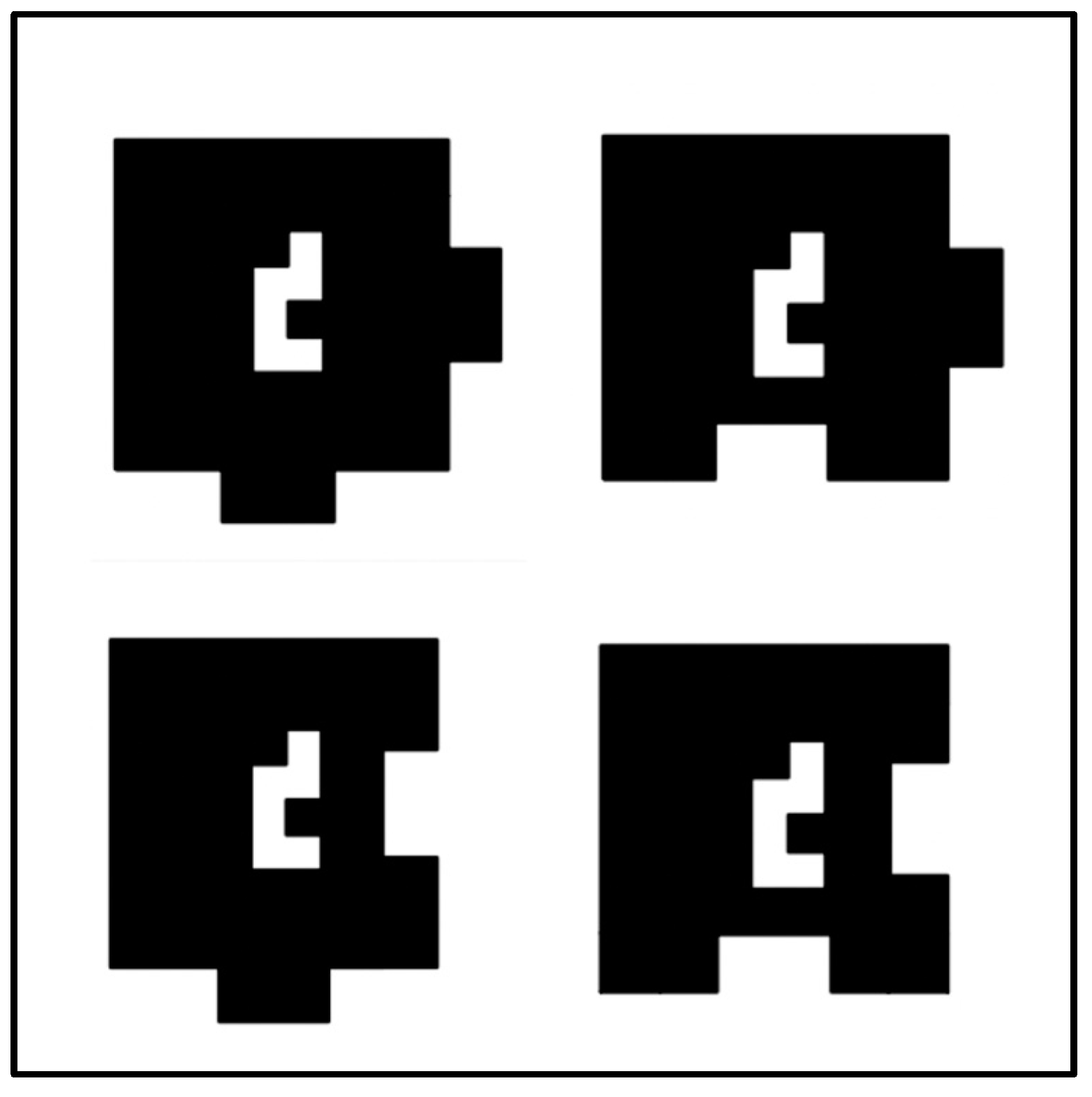
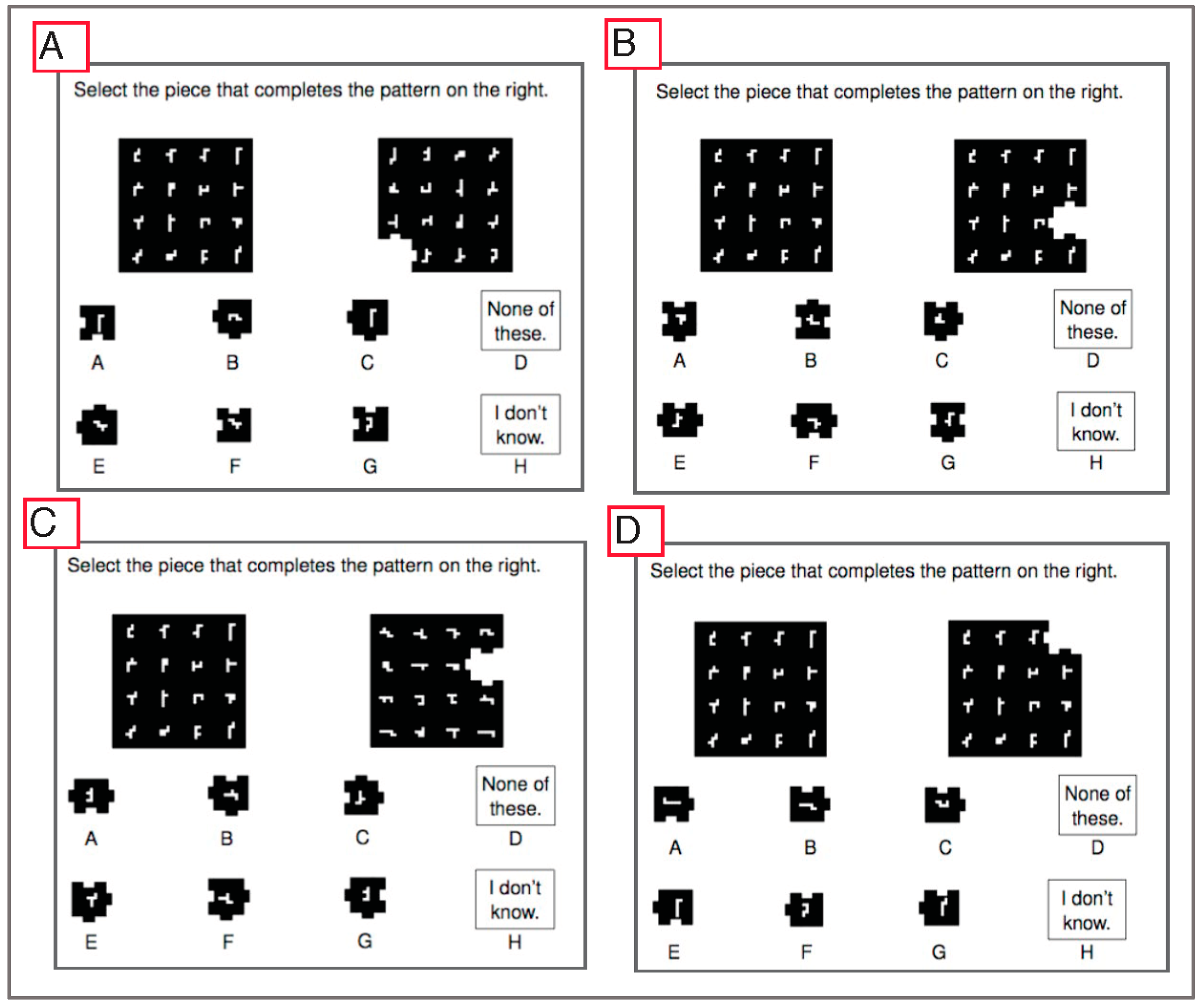
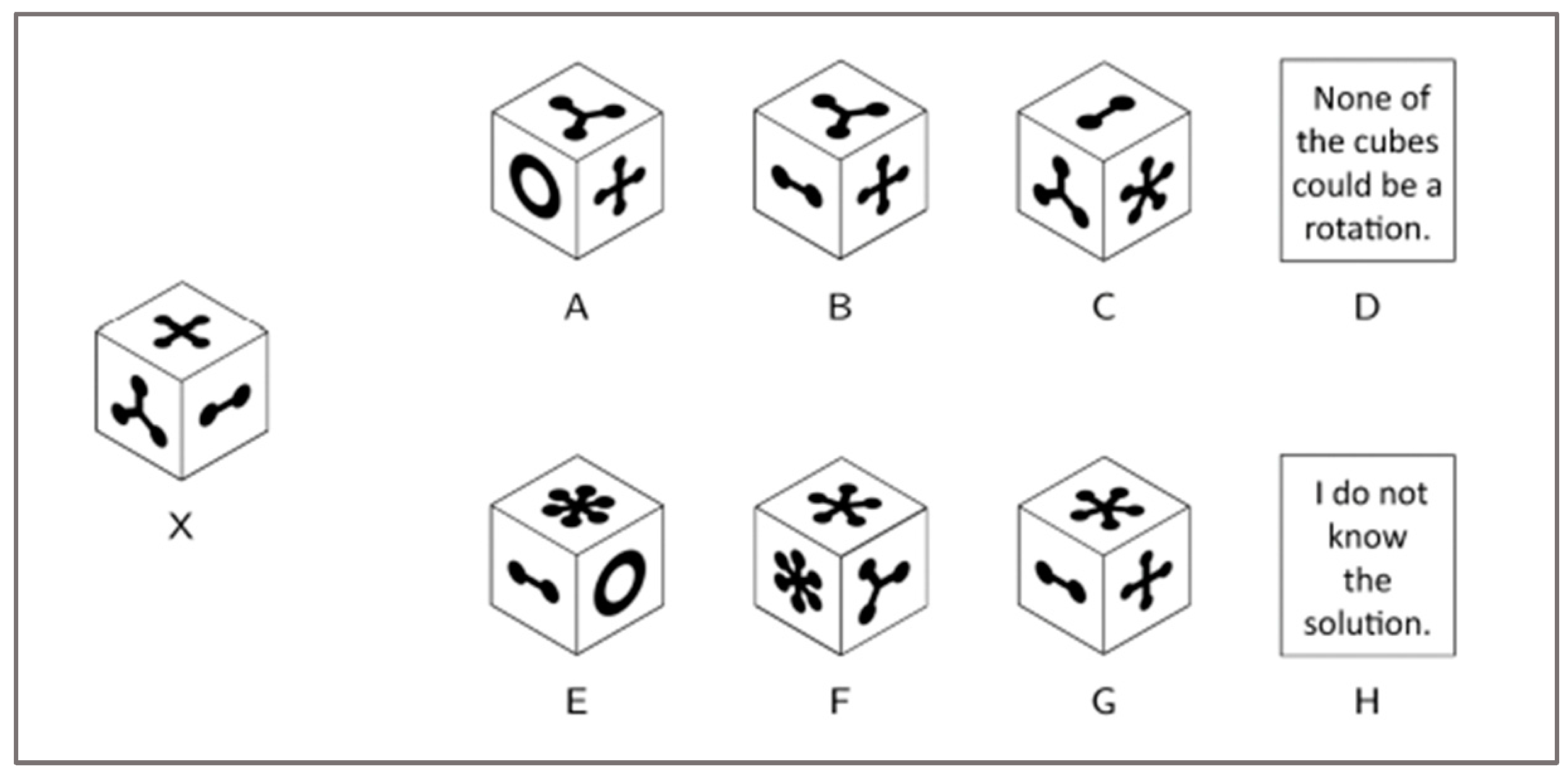

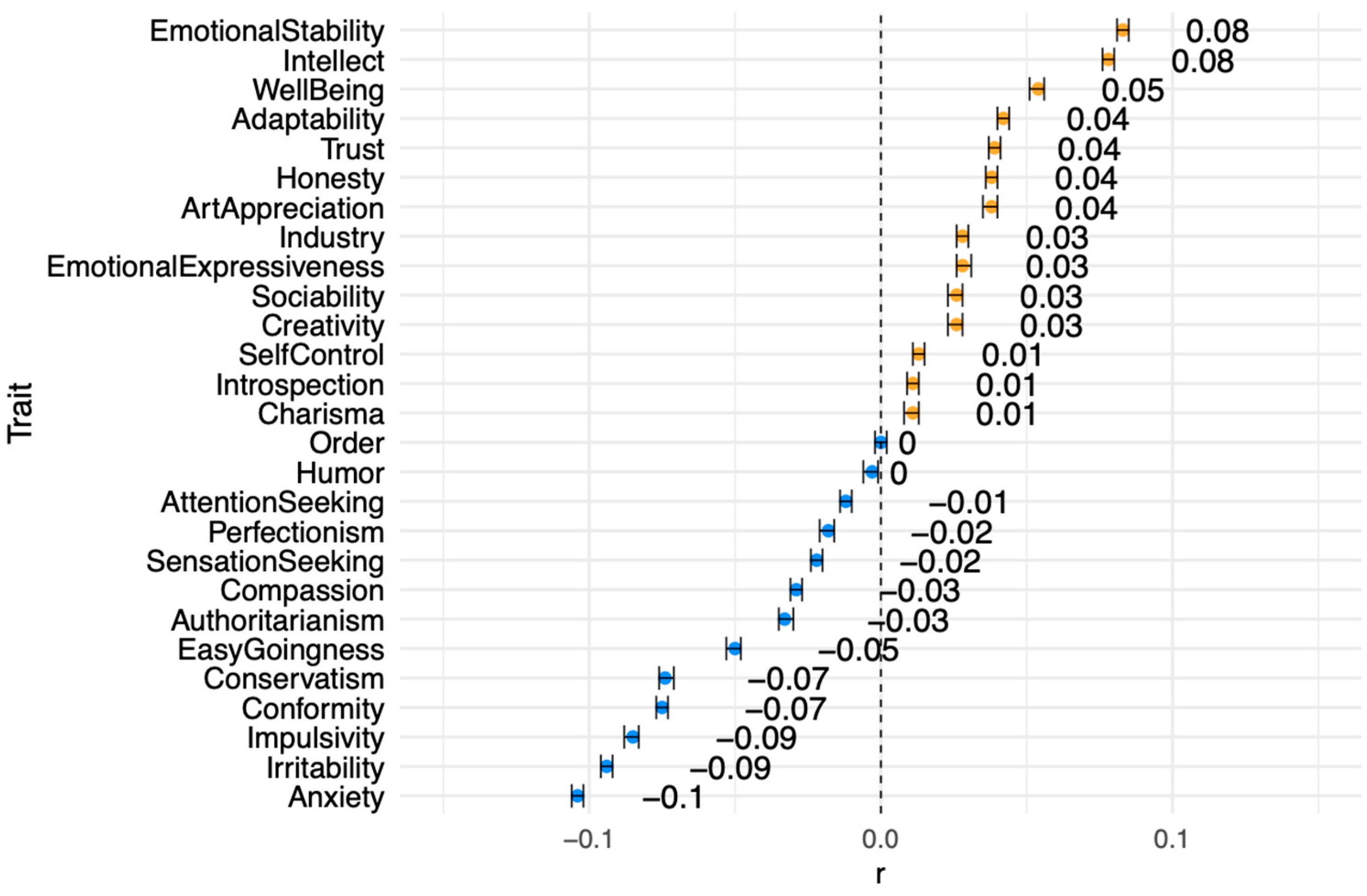
| Variable | M | SD | 1 | 2 | 3 | 4 | 5 | 6 | 7 | 8 |
|---|---|---|---|---|---|---|---|---|---|---|
| 1. Two-dimensional rotation | 50 | 10 | - | |||||||
| 2. Figural analogies | 49.70 | 5.50 | 0.20 | - | ||||||
| 3. Propositional reasoning | 49.39 | 6.21 | 0.19 | 0.24 | - | |||||
| 4. Letter–number series | 47.76 | 6.62 | 0.24 | 0.26 | 0.27 | - | ||||
| 5. Three-dimensional rotation | 49.51 | 5.85 | 0.22 | 0.22 | 0.20 | 0.23 | - | |||
| 6. Matrix reasoning | 48.79 | 5.34 | 0.23 | 0.25 | 0.22 | 0.32 | 0.22 | - | ||
| 7. Verbal reasoning | 47.91 | 5.88 | 0.21 | 0.20 | 0.26 | 0.32 | 0.21 | 0.25 | - | |
| 8. Compound remote associates | 50 | 5.98 | 0.17 | 0.18 | 0.23 | 0.24 | 0.19 | 0.19 | 0.25 | - |
| Variable | M | SD | 1 | 2 | 3 | 4 | 5 | 6 |
|---|---|---|---|---|---|---|---|---|
| 1. Two-dimensional rotation | 50 | 10 | - | |||||
| 2. Agreeableness | 4.22 | 0.88 | 0.04 | - | ||||
| 3. Conscientiousness | 3.95 | 0.97 | 0.02 | 0.21 | - | |||
| 4. Extraversion | 3.31 | 1.11 | 0.01 | 0.14 | 0.08 | - | ||
| 5. Neuroticism | 4.08 | 1.08 | −0.10 | −0.09 | −0.20 | −0.16 | - | |
| 6. Openness | 4.58 | 0.81 | 0.05 | 0.09 | 0.16 | 0.10 | −0.05 | - |
| Frequency | Mean Correlation | Standard Deviation | |
|---|---|---|---|
| 20 strongest positive associations | |||
| Engineering and technology | 10 | 0.52 | 0.02 |
| Investigative | 10 | 0.51 | 0.01 |
| Physics knowledge | 10 | 0.48 | 0.02 |
| Technology design | 10 | 0.48 | 0.02 |
| Science | 10 | 0.48 | 0.01 |
| Mathematics skills | 10 | 0.48 | 0.01 |
| Mathematical reasoning | 10 | 0.47 | 0.01 |
| Mathematics knowledge | 10 | 0.47 | 0.01 |
| Design | 10 | 0.46 | 0.02 |
| Analytical thinking | 10 | 0.46 | 0.01 |
| Systems analysis | 10 | 0.45 | 0.01 |
| Estimating the quantifiable characteristics of products, events, or information | 10 | 0.45 | 0.01 |
| Information ordering | 10 | 0.45 | 0.02 |
| Programming | 10 | 0.44 | 0.01 |
| Category flexibility | 10 | 0.44 | 0.02 |
| Number facility | 10 | 0.43 | 0.01 |
| Operations analysis | 10 | 0.42 | 0.01 |
| Complex problem solving | 10 | 0.42 | 0.01 |
| Analyzing data or information | 10 | 0.42 | 0.01 |
| Visualization | 10 | 0.39 | 0.02 |
| 20 strongest negative associations | |||
| Therapy and counseling | 10 | −0.20 | 0.01 |
| Enterprising | 9 | −0.20 | 0.02 |
| Stress tolerance | 10 | −0.21 | 0.01 |
| Physical proximity | 10 | −0.21 | 0.01 |
| Social perceptiveness | 10 | −0.22 | 0.01 |
| Spend time making repetitive motions | 10 | −0.23 | 0.01 |
| Deal With physically aggressive people | 10 | −0.26 | 0.01 |
| Clerical | 10 | −0.26 | 0.01 |
| Assisting and caring for others | 10 | −0.27 | 0.01 |
| Service orientation | 10 | −0.29 | 0.01 |
| Contact with others | 10 | −0.31 | 0.02 |
| Deal with external customers | 10 | −0.32 | 0.02 |
| Social | 10 | −0.32 | 0.01 |
| Self-control | 10 | −0.33 | 0.01 |
| Concern for others | 10 | −0.34 | 0.01 |
| Relationships | 10 | −0.35 | 0.01 |
| Social orientation | 10 | −0.35 | 0.01 |
| Performing for or working directly with the public | 10 | −0.37 | 0.01 |
| Customer and personal service | 10 | −0.38 | 0.02 |
| Deal with unpleasant or angry people | 10 | −0.40 | 0.01 |
| Occupation | N | R2D | R3D | Difference |
|---|---|---|---|---|
| Chemical engineer | 606 | 0.91 | 0.93 | −0.02 |
| Chemist | 595 | 0.91 | 0.92 | −0.01 |
| Aerospace engineer | 567 | 0.90 | 0.96 | −0.06 |
| Biologists | 720 | 0.90 | 0.91 | −0.01 |
| Computer systems engineer/architect | 1791 | 0.89 | 0.95 | −0.06 |
| Mechanical engineer | 1457 | 0.89 | 0.91 | −0.02 |
| Network and computer systems administrator | 1099 | 0.86 | 0.88 | −0.02 |
| Web developer | 1349 | 0.84 | 0.92 | −0.08 |
| Computer software engineer | 6373 | 0.83 | 0.93 | −0.1 |
| Automotive engineer | 539 | 0.83 | 0.84 | −0.01 |
| Architect | 2214 | 0.82 | 0.81 | 0.01 |
| Electrical engineer | 1329 | 0.82 | 0.86 | −0.04 |
| Engineering manager | 851 | 0.82 | 0.93 | −0.11 |
| Business intelligence analyst | 1640 | 0.81 | 0.88 | −0.07 |
| Electronics engineer | 821 | 0.81 | 0.86 | −0.05 |
| Veterinarian | 560 | 0.81 | 0.82 | −0.01 |
| Electrical and electronics installer and/or repairer | 605 | 0.80 | 0.67 | 0.13 |
| Computer and information systems manager | 1271 | 0.80 | 0.90 | −0.1 |
| Other—military officer special and tactical operations leader/manager | 839 | 0.80 | 0.72 | 0.08 |
| Computer programmer | 4666 | 0.78 | 0.91 | −0.13 |
| Occupation | N | R2D | R3D | Difference |
|---|---|---|---|---|
| Aerospace engineer | 567 | 0.90 | 0.96 | −0.06 |
| Computer systems engineer/architect | 1791 | 0.89 | 0.95 | −0.06 |
| Computer software engineer | 6373 | 0.83 | 0.93 | −0.1 |
| Chemical engineer | 606 | 0.91 | 0.93 | −0.02 |
| Engineering manager | 851 | 0.82 | 0.93 | −0.11 |
| Web developer | 1349 | 0.84 | 0.92 | −0.08 |
| Chemist | 595 | 0.91 | 0.92 | −0.01 |
| Computer programmer | 4666 | 0.78 | 0.91 | −0.13 |
| Mechanical engineer | 1457 | 0.89 | 0.91 | −0.02 |
| Biologist | 720 | 0.90 | 0.91 | −0.01 |
| Computer and information systems manager | 1271 | 0.80 | 0.90 | −0.1 |
| Business intelligence analyst | 1640 | 0.81 | 0.88 | −0.07 |
| Computer security specialist | 786 | 0.73 | 0.88 | −0.15 |
| Network and computer systems administrator | 1099 | 0.86 | 0.88 | −0.02 |
| Electrical engineer | 1329 | 0.82 | 0.86 | −0.04 |
| Electronics engineer | 821 | 0.81 | 0.86 | −0.05 |
| Information technology project manager | 2273 | 0.77 | 0.85 | −0.08 |
| Automotive engineer | 539 | 0.83 | 0.84 | −0.01 |
| Management analyst | 1807 | 0.73 | 0.82 | −0.09 |
| Veterinarian | 560 | 0.81 | 0.82 | −0.01 |
| Major | N | R2D | R3D | Difference |
|---|---|---|---|---|
| Neuroscience | 1269 | 1 | 1 | 0.00 |
| Applied mathematics | 1579 | 0.99 | 0.98 | 0.01 |
| Physics | 5664 | 0.99 | 0.99 | 0.00 |
| Materials science and engineering | 1470 | 0.98 | 0.96 | 0.02 |
| Biomedical engineering | 2413 | 0.97 | 0.97 | 0.00 |
| Manufacturing and design engineering | 1733 | 0.96 | 0.73 | 0.23 |
| Mathematics | 6953 | 0.95 | 0.94 | 0.01 |
| Chemical and biological engineering | 5797 | 0.94 | 0.92 | 0.02 |
| Mechanical engineering | 14,670 | 0.93 | 0.88 | 0.05 |
| Aerospace engineering | 2682 | 0.92 | 0.89 | 0.03 |
| Anthropology | 2438 | 0.91 | 0.93 | −0.02 |
| Geological sciences | 2512 | 0.90 | 0.85 | 0.05 |
| Industrial engineering | 3834 | 0.88 | 0.90 | −0.02 |
| Chemistry | 8269 | 0.88 | 0.86 | 0.02 |
| Actuarial sciences | 941 | 0.86 | 0.88 | −0.02 |
| Biology | 19,049 | 0.86 | 0.86 | 0.00 |
| Other mathematics major | 896 | 0.85 | 0.79 | 0.06 |
| Landscape design | 587 | 0.84 | 0.64 | 0.20 |
| Religion | 987 | 0.83 | 0.84 | −0.01 |
| Electrical engineering | 16,634 | 0.82 | 0.77 | 0.05 |
| Major | N | R2D | R3D | Difference |
|---|---|---|---|---|
| Neuroscience | 1269 | 1 | 1 | 0.00 |
| Physics | 5664 | 0.99 | 0.99 | 0.00 |
| Applied mathematics | 1579 | 0.99 | 0.98 | 0.01 |
| Biomedical engineering | 2413 | 0.97 | 0.97 | 0.00 |
| Materials science and engineering | 1470 | 0.98 | 0.96 | 0.02 |
| Philosophy | 2818 | 0.81 | 0.95 | −0.14 |
| Mathematics | 6953 | 0.95 | 0.94 | 0.01 |
| Anthropology | 2438 | 0.91 | 0.93 | −0.02 |
| Chemical and biological engineering | 5797 | 0.94 | 0.92 | 0.02 |
| Music | 3989 | 0.79 | 0.91 | −0.12 |
| Industrial engineering | 3834 | 0.88 | 0.90 | −0.02 |
| Aerospace engineering | 2682 | 0.92 | 0.89 | 0.03 |
| Mechanical engineering | 14,670 | 0.93 | 0.88 | 0.05 |
| Actuarial sciences | 941 | 0.86 | 0.88 | −0.02 |
| Statistics | 2174 | 0.77 | 0.87 | −0.10 |
| Biology | 19,049 | 0.86 | 0.86 | 0.00 |
| Chemistry | 8269 | 0.88 | 0.86 | 0.02 |
| Geological sciences | 2512 | 0.90 | 0.85 | 0.05 |
| Religion | 987 | 0.83 | 0.84 | −0.01 |
| Music education | 712 | 0.73 | 0.82 | −0.09 |
Disclaimer/Publisher’s Note: The statements, opinions and data contained in all publications are solely those of the individual author(s) and contributor(s) and not of MDPI and/or the editor(s). MDPI and/or the editor(s) disclaim responsibility for any injury to people or property resulting from any ideas, methods, instructions or products referred to in the content. |
© 2023 by the authors. Licensee MDPI, Basel, Switzerland. This article is an open access article distributed under the terms and conditions of the Creative Commons Attribution (CC BY) license (https://creativecommons.org/licenses/by/4.0/).
Share and Cite
Mather, K.A.; Condon, D.M. Development of a Public-Domain Measure of Two-Dimensional Rotation Ability and Preliminary Evidence for Discriminant Validity among Occupations. J. Intell. 2023, 11, 191. https://doi.org/10.3390/jintelligence11100191
Mather KA, Condon DM. Development of a Public-Domain Measure of Two-Dimensional Rotation Ability and Preliminary Evidence for Discriminant Validity among Occupations. Journal of Intelligence. 2023; 11(10):191. https://doi.org/10.3390/jintelligence11100191
Chicago/Turabian StyleMather, Kendall A., and David M. Condon. 2023. "Development of a Public-Domain Measure of Two-Dimensional Rotation Ability and Preliminary Evidence for Discriminant Validity among Occupations" Journal of Intelligence 11, no. 10: 191. https://doi.org/10.3390/jintelligence11100191
APA StyleMather, K. A., & Condon, D. M. (2023). Development of a Public-Domain Measure of Two-Dimensional Rotation Ability and Preliminary Evidence for Discriminant Validity among Occupations. Journal of Intelligence, 11(10), 191. https://doi.org/10.3390/jintelligence11100191





